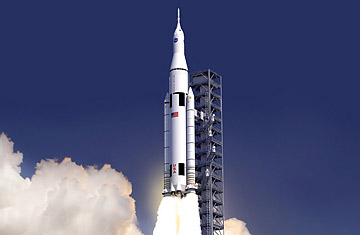
An artist's rendering of the Space Launch System, NASA's advanced heavy-lift launch vehicle that will provide an entirely new capability for human exploration in space
Want to make a space geek dreamy (O.K., dreamier than usual)? Just mention the Saturn V rocket. Thirty-six stories of big-muscle booster, the Saturn V produced 3.4 million kg (7.5 million lb.) of thrust, could carry 120 metric tons of payload, launched 24 astronauts to the moon and put America's first space station in orbit. Then, in 1973, it was forever mothballed.
But those same geeks beamed this week when NASA revealed its plans for its next generation heavy-lift booster. It's designed for deep-space destinations like the Saturn V; it can lift a lot of tons like the Saturn V; it even looks like the Saturn V — eye candy of the first order. "President Obama challenged us to be bold and dream big, and that's exactly what we're doing at NASA," said space-agency administrator and former astronaut Charles Bolden. "While I was proud to fly on the shuttle, tomorrow's explorers will now dream of one day walking on Mars."
That's exactly the kind of aim-high talk such a public unveiling usually gets — and often deserves. Despite such official breathlessness, however, there are real concerns around NASA and in Washington that dreaming is what the backers of this project will get. The plan for the rocket is indeed a good one, but if recent decades are any indication, the prospects of anyone ever seeing it fly are murky at best.
The new space-launch system, officially known as, well, the Space Launch System (SLS), has a convoluted past. In 2004, the Bush Administration charged NASA with building ships that could take Americans back to the moon and onto Mars, with a target date of 2020 for the first lunar landing. The agency happily accepted the challenge and set about building a new crew vehicle — dubbed Orion, sort of an Apollo on steroids — and a pair of boosters. The Ares I, the smaller of the two rockets, would take astronauts to low Earth orbit; its big brother, the Ares V, would hurl them beyond. The rough design of the rockets was smart: an assemblage of engines proved in previous missions, but updated and repurposed for future ones. This "legacy hardware" included the main engines and the solid rocket boosters from the space shuttle and a modernized version of the Saturn V's upper-stage J-2 engine, which would be known as the J-2X. All of those motors have an exceptional performance history — with, of course, the tragic exception of the solid rockets' leaky O-rings that destroyed the shuttle Challenger. That problem was corrected.
But with hardware development behind schedule and the economy flagging, the incoming Obama Administration scrapped the Bush plan, outsourcing the low-Earth part of the mission to the private sector and putting off the development of a heavy-lift booster for five years or more. Congress, however — specifically lawmakers from Texas and Florida — rebelled, and the Administration agreed to resume work on just the crew capsule and the heavy lift. That pleased space watchers, and the announcement of the SLS plans this week thrilled them. What makes that announcement a little disingenuous is NASA's and Washington's boasts about the novelty of the design.
"Having settled on a new and powerful heavy-lift architecture, NASA can now move ahead with building that rocket," said John Holdren, an Obama Administration adviser on science and technology. "I'm excited about NASA's new path forward."
